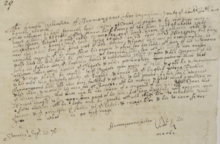Harman Garrett
Harman Garrett (c. 1610[1] – c. 1678) (also known as Cashawashett or Wequashcook II or Herman Garrett or Harmon Garrett[2]) was a Niantic sachem and then governor of the Eastern Pequots slightly east of the Pawcatuck River in Westerly, Rhode Island. His chosen English name was very similar to that of Herman Garrett, a colonial gunsmith who had resided in Concord.


Garrett was the son of Eastern Niantic sachem Wepitanock (also known as Momojosbuck or Wettamozo) and his unnamed wife (who may have been a Pequot) and the grandson of sachem Saccious.[3] He was also the brother of Wequash Cooke, who helped the colonial military during the Pequot War in 1637 in defeating the Pequots. After Wequash Cook's death in 1642, Garrett assumed his brother's name and role, but his uncle Ninigret contested this because Garrett's mother was not Niantic, making him only half Niantic.[4] In the 1640s, Garrett worked with John Mason to negotiate his territorial boundaries and his right to be a leader of the Pequots. John Winthrop, Jr. and Robin Cassacinamon briefly held Garrett in 1648/49 on house arrest, but Winthrop became Garrett's ally and advocated his Pawcatuck settlement.[5]
Uncas allegedly paid an Indian named Wampushet to attack another Indian with a hatchet and then to falsely blame Garrett for ordering the attack. Wampushet gave testimony before the United Colonies with Uncas present, but it was unclear who ordered the attack.[6] The Commissioners of the United Colonies appointed Garrett governor over the Pequots and Niantics at Pawcatuck and Wekapauge in September 1655 to collect tributes that were owed since the Pequot War and to mediate disputes, and they appointed Thomas Stanton to work with him. Encroachments and land disputes occurred with nearby settlers, causing him to move to Southertowne (Stonington) in 1663. In 1661, Massachusetts authorities mediated a territorial dispute between Garrett and his uncle Ninigret regarding the land in and around Westerly.[7]
Garrett took the name of Massachusetts gunsmith Herman Garrett by 1661, who was an associate of Willard.[8][9] Garrett, Oneco, and Cassasinamon jointly executed Narragansett Sachem Canonchet in 1675 during King Philip's War, while fighting alongside colonial forces.[10] Garrett's group of Indians were given land in northern Stonington in 1683 after Garrett's death. His will left his property to his son Cattepeset, but Garrett's deputy Mamaho took power after Garrett's death, and a power struggle ensured with Cassacinamon's group.[11][12][13][14][15]
References
- http://www.worldstatesmen.org/US_NativeAM.html
- see: Consolidated Index to Plymouth County Records for other variations of these named are also used: Cassawashet, Cashawashed, Caushawashed, Cusawashset, Caushewashett, Cawshawshett, Caushawasett, Caushawashott, Caushawesett, Casshawashet, Coushawashett
- John William De Forest, History of the Indians of Connecticut from the Earliest Known Period (1853), pg. 181 https://books.google.com/books?id=hNxf4YjU35AC
- Benjamin Bussey Thatcher, Indian biography, or, An historical account of those individuals who ... - Indians of North America (1832) https://books.google.com/books?id=Lw0TAAAAYAAJ
- Shawn G. Wiemann, Lasting Marks: The Legacy of Robin Cassacinamon and the Survival of the Mashantucket Pequot Nation (University of New Mexico, Dissertation, 2011) http://digitalrepository.unm.edu/cgi/viewcontent.cgi?article=1082&context=hist_etds
- Shawn G. Wiemann, Lasting Marks: The Legacy of Robin Cassacinamon and the Survival of the Mashantucket Pequot Nation (University of New Mexico, Dissertation, 2011), pp. 146-148 http://digitalrepository.unm.edu/cgi/viewcontent.cgi?article=1082&context=hist_etds
- Benjamin Bussey Thatcher, Indian Biography, Or, An Historical Account of Those Individuals who ...- Indians of North America, (1832) p. 238-239 https://books.google.com/books?id=loG49p3bXbcC
- https://yipp.yale.edu/bio/bibliography/garrett-harman-englishman
- Collections of the Rhode Island Historical Society (1835), p. 256 https://books.google.com/books?id=HX0FAAAAQAAJ
- Richard Anson Wheeler, History of the First Congregational Church, Stonington, Conn., ... (1875), pg. 298 https://books.google.com/books?id=aJAsAAAAYAAJ
- Pulsifer, ACUCNE, Vol.2 (1859), 283
- LaFantasie, The Correspondence of Roger Williams, 324.
- Harold M. Chapin, Sachems of the Narragansett (Providence, 1931)
- "Garrett, Harman, -1678," Indian Papers Project, https://yipp.yale.edu/bio/bibliography/garrett-harman-1678
- Garrett's will is dated 1677 and states " He leaves all his land and business to his oldest son Cattapesett and instructs him to be faithful to the English despite the consequences he himself has endured in doing so." https://www.indianandcolonial.org/vewebsite/vex4/A822BDE4-B741-46FE-9AB6-168090924526.htm